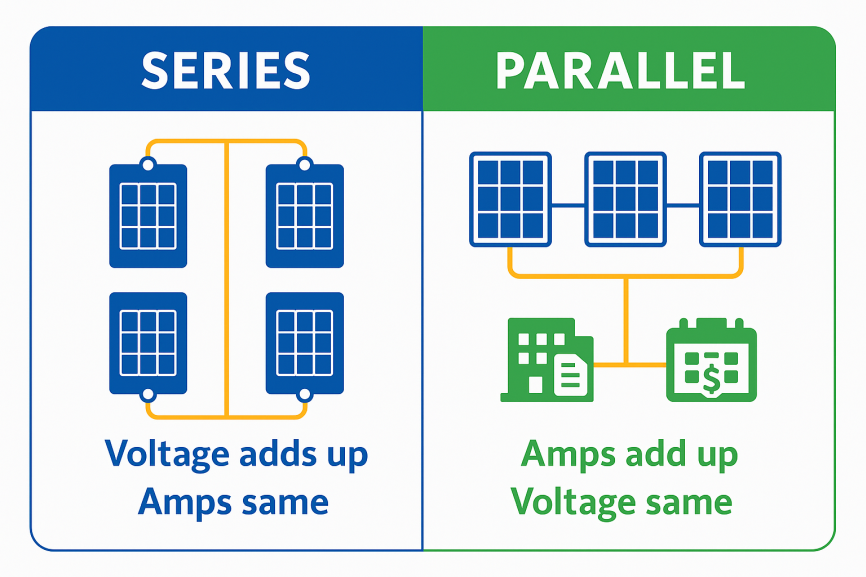Series vs Parallel Solar Panels: Which Connection Is Best?
When homeowners first explore solar, one of the most common technical questions comes up: Should solar panels be connected in series or in parallel? The truth is, there’s no universal “best” option — the right wiring method depends on your system design, shading conditions, and the inverter you’re using.
In simple terms:
- Series connections increase voltage but keep current the same.
- Parallel connections increase current but keep voltage stable.
Each setup has its strengths, weaknesses, and ideal applications. Get the wiring right, and your system will deliver maximum efficiency and faster payback. Get it wrong, and you could lose valuable energy before it even reaches your inverter.
In this guide, we’ll break down series vs parallel solar panel connections with real-world examples, pros and cons, and practical advice so you can make an informed decision.
Want to learn more about how solar systems are installed and designed? See this technical overview of photovoltaic systems and wiring.
Series vs Parallel – The Basics Explained

- Series Wiring: When solar panels are connected in series, the voltage adds up while the current (amps) stays the same. Think of it like stacking batteries end-to-end — the total voltage rises, but the flow of current remains constant. This is often used in grid-tied systems where higher voltage is more efficient for long cable runs.
- Parallel Wiring: In a parallel connection, the current adds up while the voltage stays the same. Imagine multiple lanes of traffic feeding into the same destination — more cars (current) can move at once, but the speed limit (voltage) doesn’t change. This setup is useful for shaded systems or when safety requires lower voltages.
Pros & Cons of Series Wiring
When solar panels are wired in series, the system’s voltage increases while the current remains the same. This setup is common in many residential systems and works particularly well with string inverters and MPPT (Maximum Power Point Tracking) technology. But like every wiring choice, it comes with trade-offs.
✅ Pros of Series Wiring
- Higher Voltage, Lower Current: This makes electricity flow more efficiently across long cable runs, so you can use thinner, less expensive wiring.
- String Inverter Compatibility: Most grid-tied systems with a central inverter are designed for series wiring, which allows the inverter to track and optimize power effectively.
- Efficient in Unshaded Conditions: If your panels all receive the same amount of sun, series wiring delivers strong and consistent output.
⚠️ Cons of Series Wiring
- Shading Sensitivity: The biggest drawback of series wiring is the “weakest link” problem — if one panel is shaded, the entire string’s output drops.
- Design Limitations: Voltage needs to stay within certain ranges to match inverter specifications, limiting flexibility in system layout.
- Potential Hot Spots: Shaded or damaged cells can heat up, reducing system longevity without bypass diodes.
Learn how series wiring impacts the solar panel payback period when shade is involved.
Hybrid Wiring (Series-Parallel): Best of Both Worlds?
Not every solar system sticks to just one wiring method. In many cases, installers use a series-parallel hybrid connection to balance voltage and current for optimal performance. This approach combines the strengths of both setups.

Here’s how it works:
- Series Strings: A few panels are wired in series to boost voltage.
- Parallel Strings: Those series strings are then connected in parallel to increase current and add redundancy.
This hybrid method is often used when:
- Battery banks or inverters have strict input requirements (voltage limits).
- A home system needs both long cable runs (favoring higher voltage) and shade resilience (favoring parallel wiring).
- Expansion is planned — hybrid wiring makes it easier to add more panels later.
Wiring Choice and Shading: How They Interact
Shading is one of the most important factors when deciding how to wire your solar panels. The type of connection you choose directly affects how your system handles obstructions like trees, chimneys, or seasonal sun angles.
- Series Wiring & Shading: In a pure series connection, even a single shaded panel can drag down the performance of the entire string. This is sometimes called the “Christmas light effect.” While bypass diodes help, the impact is still significant.
- Parallel Wiring & Shading: In a parallel setup, each panel operates independently. This means shaded panels affect only themselves, leaving the others to keep generating power at full output. This is one of the biggest parallel shading benefits for homeowners with partially shaded rooftops.
- Modern Mitigations: Today, technology like microinverters and power optimizers reduce the shading risks in series systems. These devices let each panel perform at its best, even if others are shaded, effectively combining the efficiency of series wiring with the resilience of parallel wiring.
Learn more about how shading and wiring impact solar ROI.
Real-World Applications
Wiring choice isn’t just theory — it makes a real difference depending on where and how solar panels are used. Let’s look at some practical scenarios:
- RVs & Tiny Homes: In smaller, off-grid setups like RVs or tiny houses, parallel wiring is often preferred. These systems typically run at lower voltages for safety, and roofs are prone to partial shading (from vents, AC units, or nearby trees at campsites). In these cozy spaces, parallel wiring ensures that one shaded panel doesn’t kill the whole array’s output.
- Massachusetts Homes (Grid-Tied): For most residential rooftops in Massachusetts, series wiring is common since it works well with string inverters and provides higher efficiency for grid-tied systems. However, if the roof has shading from trees or complex angles, adding microinverters or power optimizers makes the system far more resilient — combining efficiency with shading tolerance. This helps homeowners maximize ROI even in less-than-ideal conditions.
In short, the best wiring for a shaded roof often combines smart design with technology tailored to your environment. What works for a mobile off-grid system may not be the right choice for a two-story Massachusetts colonial, which is why a professional system design always starts with a site-specific analysis.
See how professional design impacts ROI.
FAQs – Series vs Parallel Solar
Q: Can you mix series and parallel solar panel wiring?
A: Yes — many systems use a series-parallel hybrid connection to balance voltage and current. This setup can improve efficiency while also providing shading resilience.
Q: Is parallel wiring safer for small or off-grid systems?
A: Parallel wiring typically operates at lower voltages, which is considered safer for small/off-grid systems. However, modern safety standards ensure both wiring methods are safe when installed by professionals.
Q: Which wiring setup gives you better payback?
A: It depends on your conditions. In unshaded, grid-tied systems, series wiring with a string inverter usually delivers better efficiency. But in shaded environments, parallel wiring (or series with microinverters/optimizers) can improve ROI by reducing energy losses.
Conclusion – Choosing the Right Connection for Your Home
So, should you wire solar panels in series or parallel? The best choice depends entirely on your system’s goals. If your home needs higher voltage and long wire runs, series wiring with a string inverter may be the most efficient option. If you have shaded areas or safety concerns, parallel wiring — or series with microinverters or optimizers — will often give you better performance.
At the end of the day, wiring isn’t one-size-fits-all. A professional installer will consider your roof, inverter, and shading conditions before recommending the right design.
✅ Ready to get the best design for your home?
Get a custom solar design that wires smart and pays fast
